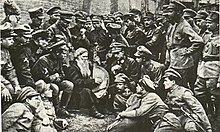Ukrainian-Soviet War
The Ukrainian-Soviet War (Ukrainian Українсько-радянська війна Ukrajinsko-radjanska wijna ) was a military conflict between the Army of the Ukrainian People's Republic and the Russian and Ukrainian Red Guards in Ukraine from December 1917 to April 1918. It was continued until 1921 with the participation of German , Austrian , Polish , Romanian , French and Greek armies. After that, most of it belonged to the Ukrainian Soviet Socialist Republic , the western part to Poland .
prehistory
After the February Revolution of 1917 , the Central Na Rada was formed as the central decision-making body in the Ukrainian areas of the Russian Empire .
In the Third Universal of November 19, 1917, it proclaimed the Ukrainian People's Republic as an autonomous state within the Russian Soviet Republic after the October Revolution . Kiev became the capital . In the elections that followed, Ukrainian nationalist parties won 75% of the vote and the Bolsheviks 25%.
Soviet conquest 1917–1918
In December 1917, Soviet Russian units of the former Russian Army and Red Guards , made up of workers in the Donetsk Governorate and Donbass , began a military offensive from the northeast into Ukraine. They were led by Vladimir Antonov-Ovsejenko and Mikhail Muravyov . On December 11 and 12, Bolshevik uprisings took place in Kiev , Odessa and Vinnytsia in support of them. They were put down by units of the Ukrainian People's Republic.
On 24./25. December the first congress of the deputies of the peasants', workers' and soldiers' councils took place in Kharkiv . On December 26th, the Soviet units captured Kharkiv. On December 30th, the Ukrainian People's Republic of the Soviets was declared there .
On January 9, 1918, the Soviet troops captured Yekaterinoslav , and on January 15, Alexandrovsk . On January 18, Odessa declared itself a Soviet city and founded the Soviet Republic of Odessa . On January 20th, the Soviet troops captured Poltava . On January 29, small units of the Ukrainian People's Army tried to stop the advance of Soviet troops on Kiev in the battle of Kruty .
On the same day a Bolshevik uprising took place in Kiev , which was soon crushed by the Ukrainian People's Republic. On February 9, 1918, the Red Guards captured Kiev, ruling most of eastern Ukraine.
On the same day the government of the Ukrainian People's Republic concluded with the Central Powers the Treaty of Brest-Litovsk ( bread peace ). She moved her seat to Zhytomyr .
On February 12, the Donetsk-Krivoy Rog Soviet Republic was formed in Kharkiv .
German and Austrian conquest in 1918
On February 18, 1918, troops of the German Empire began to march into the western areas of Soviet Russia . On February 24th they conquered Zhytomyr, Ukraine. Since they met little resistance, they were able to take Kiev on March 3rd. On March 13, Austrian troops captured Odessa.
The Soviet-Ukrainian government moved its headquarters to Kharkiv and founded the Ukrainian Soviet Republic there on March 19 . On April 18, Kharkiv came under German control. That was the end of the Soviet government in Ukraine for the time being. On April 29th, the German occupying power formed the Ukrainian state as a hetmanate for the whole of Ukraine.
In November, the German troops withdrew from Ukraine after the November Revolution.
Further development 1919–1921
In January 1919, the Soviet troops captured Kiev and founded the Ukrainian Soviet Socialist Republic .
French and Greek troops intervened in the south.
Between 1919 and 1921 the Polish-Soviet war raged in the Ukraine . In the Peace of Riga Ukraine was divided again, parts of western Ukraine came to Poland , the rest and Crimea came to the USSR .
See also
literature
- Paul Robert Magocsi : A History of Ukraine. Toronto: University of Toronto Press, 1996, ISBN 0-8020-0830-5 (English).
Individual evidence
- ↑ a b Ukrainian-Soviet War, 1917-21. Encyclopedia of Ukraine
- ↑ Frank Grelka: The Ukrainian national movement under German occupation rule in 1918 and 1941-42 (= studies of the research center Eastern Europe at the University of Dortmund , Vol. 38), Harrassowitz Verlag, Wiesbaden 2005, ISBN 3-447-05259-7 , p 60 f . ( books.google.de ).
